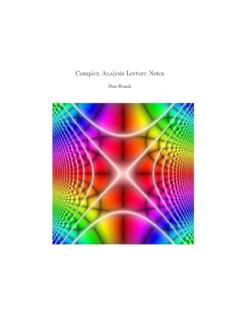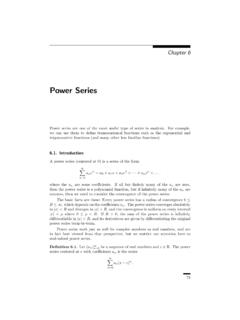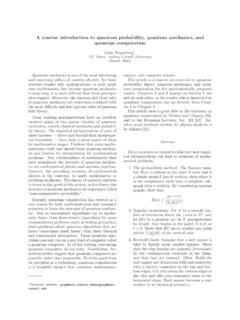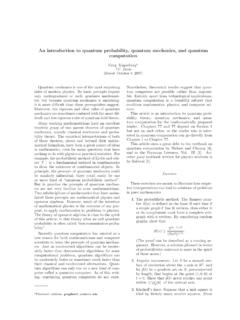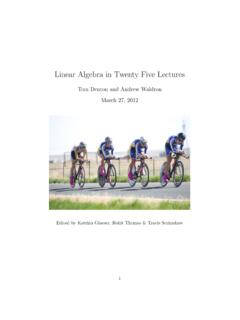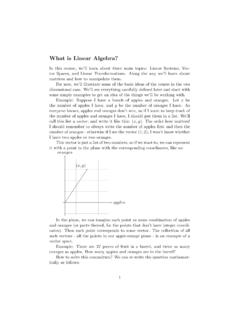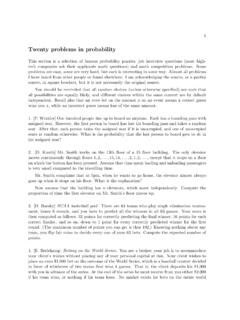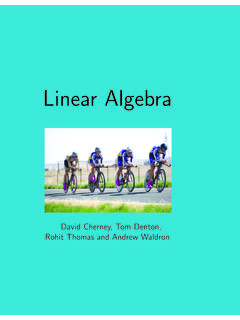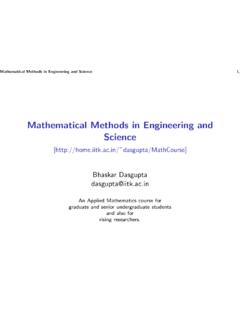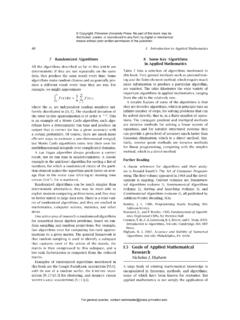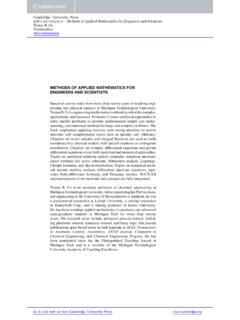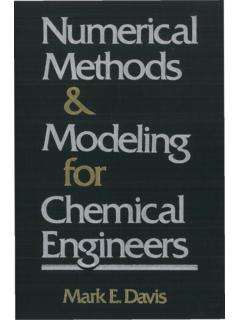Transcription of LECTURE NOTES ON APPLIED MATHEMATICS
1 LECTURE NOTES ONAPPLIED MATHEMATICSM ethods and ModelsJohn K. HunterDepartment of MathematicsUniversity of California, DavisJune 17, 2009 Copyrightc 2009 by John K. HunterContentsLecture 1. Introduction11. Conservation laws12. Constitutive equations23. The KPP equation3 LECTURE 2. Dimensional Analysis, Scaling, and Similarity111. Systems of units112. Scaling123. Nondimensionalization134. Fluid mechanics135. Stokes formula for the drag on a sphere186. Kolmogorov s 1941 theory of turbulence227. Self-similarity258. The porous medium equation279. Continuous symmetries of differential equations33 LECTURE 3. The Calculus of Variations431. Motion of a particle in a conservative force field442. The Euler-Lagrange equation493. Newton s problem of minimal resistance514. Constrained variational principles565. Elastic rods576. Buckling and bifurcation theory617.
2 Laplace s equation698. The Euler-Lagrange equation739. The wave equation7610. Hamiltonian mechanics7611. Poisson brackets7912. Rigid body rotations8013. Hamiltonian PDEs8614. Path integrals88 LECTURE 4. Sturm-Liouville Eigenvalue Problems951. Vibrating strings962. The one-dimensional wave equation993. Quantum mechanics1034. The one-dimensional Schr odinger equation1065. The Airy equation1166. Dispersive wave propagation1187. Derivation of the KdV equation for ion-acoustic waves121iii8. Other Sturm-Liouville problems127 LECTURE 5. Stochastic Processes1291. Probability1292. Stochastic processes1363. Brownian motion1414. Brownian motion with drift1485. The Langevin equation1526. The stationary Ornstein-Uhlenbeck process1577. Stochastic differential equations1608. Financial models167 Bibliography173 LECTURE 1 IntroductionThe source of all great MATHEMATICS is the special case, the con-crete example.
3 It is frequent in MATHEMATICS that every instanceof a concept of seemingly great generality is in essence the sameas a small and concrete special begin by describing a rather general framework for the derivation of PDEsthat describe the conservation, or balance, of some Conservation lawsWe consider a quantityQthat varies in space,~x, and time,t, with densityu(~x,t),flux~q(~x,t), and source density (~x,t).For example, ifQis the mass of a chemical species diffusing through a stationarymedium, we may takeuto be the density,~qthe mass flux, andfthe mass rate perunit volume at which the species is simplicity, we suppose thatu(x,t) is scalar-valued, but exactly the sameconsiderations would apply to a vector-valued density (leading to a system of equa-tions). Integral formThe conservation ofQis expressed by the condition that, for any fixed spatialregion , we have( )ddt ud~x= ~q ~ndS+ d~ , is the boundary of ,~nis the unit outward normal, anddSdenotesintegration with respect to surface ( ) is the integral form of conservation ofQ.
4 It states that, for anyregion , the rate of change of the total amount ofQin is equal to the rateat whichQflows into through the boundary plus the rate at whichQisgenerated by sources inside . Differential formBringing the time derivative in ( ) inside the integral over the fixed region , andusing the divergence theorem, we may write ( ) as utd~x= ( ~q+ )d~x1P. this equation holds for arbitrary regions , it follows that, for smooth func-tions,( )ut= ~q+ .Equation ( ) is the differential form of conservation the source term is nonzero, ( ) is often called, with more accuracy,a balance law forQ, rather than a conservation law, but we won t insist on Constitutive equationsThe conservation law ( ) is not a closed equation for the densityu. Typically,we supplement it with constitutive equations that relate the flux~qand the sourcedensity touand its derivatives.
5 While the conservation law expresses a gen-eral physical principle, constitutive equations describe the response of a particularsystem being the flux and source are pointwise functions of the density,~q=~f(u), =g(u),then we get a first-order system of PDEsut+ ~f(u) =g(u).For example, in one space dimension, ifg(u) = 0 andf(u) =u2/2, we get theinviscid Burgers equationut+(12u2)x= equation is a basic model equation for hyperbolic systems of conservation laws,such as the compressible Euler equations for the flow of an inviscid compressiblefluid [47].Example that the flux is a linear function of the density gradient,( )~q= A u,whereAis a second-order tensor, that is a linear map between vectors. It isrepresented by ann nmatrix with respect to a choice ofnbasis vectors. Then,if = 0, we get a second order, linear PDE foru(~x,t)( )ut= (A u).Examples of this constitutive equation include: Fourier s law in heat conduction(heat flux is a linear function of temperature gradient); Fick s law (flux of solute isa linear function of the concentration gradient); and Darcy s law (fluid velocity ina porous medium is a linear function of the pressure gradient).
6 It is interesting tonote how old each of these laws is: Fourier (1822); Fick (1855); Darcy (1855).The conductivity tensorAin ( ) is usually symmetric and positive-definite,in which case ( ) is a parabolic PDE; the corresponding PDE for equilibriumdensity distributionsu(~x) is then an elliptic equation (A u) = general, the conductivity tensor may depend upon~xin a nonuniform system,and onuin non-linearly diffusive systems. WhileAis almost always symmetric, LECTURE 1. INTRODUCTION3it need not be diagonal in an anisotropic system. For example, the heat flux ina crystal lattice or in a composite medium made up of alternating thin layers ofcopper and asbestos is not necessarily in the same direction as the a uniform, isotropic, linear system, we haveA= Iwhere is a positiveconstant, and thenu(~x,t) satisfies the heat, or diffusion, equationut= solutions satisfy Laplace s equation u= The KPP equationIn this section, we discuss a specific example of an equation that arises as a modelin population dynamics and Reaction-diffusion equationsIf~q= uand =f(u) in ( ), we get areaction-diffusionequationut= u+f(u).
7 Spatially uniform solutions satisfy the ODEut=f(u),which is the reaction equation. In addition, diffusion couples together the solutionat different equations arise, for example, as models of spatially nonuniform chemicalreactions, and of population dynamics in spatially distributed combined effects of spatial diffusion and nonlinear reaction can lead to theformation of many different types of spatial patterns; the spiral waves that occurin Belousov-Zabotinski reactions are one of the simplest reaction-diffusion equations is the KPP equation (or Fisherequation)( )ut= uxx+ku(a u).Here, ,k,aare positive constants; as we will show, they may be set equal to 1without loss of ( ) was introduced independently by Fisher [22], and Kolmogorov,Petrovsky, and Piskunov [33] in 1937. It provides a simple model for the dispersionof a spatially distributed species with population densityu(x,t) or, in Fisher s work,for the advance of a favorable allele through a spatially distributed Maximum principleAccording to the maximum principle, the solution of ( ) remains nonnegative ifthe initial datau0(x) =u(x,0) is non-negative, which is consistent with its use asa model of population or maximum principle holds because ifufirst crosses from positive to negativevalues at timet0at the pointx0, and ifu(x,t) has a nondegenerate minimum atx0,thenuxx(x0,t0)>0.
8 Hence, from ( ),ut(x0,t0)>0, soucannot evolve forwardin time into the regionu <0. A more careful argument is required to deal withdegenerate minima, and with boundaries, but the conclusion is the same [18, 42].A similar argument shows thatu(x,t) 1 for allt 0 ifu0(x) forth-order diffusion equation, such asut= uxxxx+u(1 u),does not satisfy a maximum principle, and it is possible for positive initial data toevolve into negative Logistic equationSpatially uniform solutions of ( ) satisfy the logistic equation( )ut=ku(a u).This ODE has two equilibrium solutions atu= 0,u= solutionu= 0 corresponds to a complete absence of the species, andis unstable. Small disturbances grow initially likeu0ekat. The solutionu=acorresponds to the maximum population that can be sustained by the availableresources. It is globally asymptotically stable, meaning that any solution of ( )with a strictly positive initial value approachesaast.
9 Thus, the PDE ( ) describes the evolution of a population that satisfies lo-gistic dynamics at each point of space coupled with dispersal into regions of NondimensionalizationBefore discussing ( ) further, we simplify the equation by rescaling the variablesto remove the constants. Letu=U u, x=L x, t=T twhereU,L,Tare arbitrary positive constants. Then x=1L x, t=1T follows that u( x, t) satisfies u t=( TL2) u x x+ (kTU) u(aU u).Therefore, choosing( )U=a, T=1ka, L= ka,and dropping the bars, we find thatu(x,t) satisfies( )ut=uxx+u(1 u).Thus, in the absence of any other parameters, none of the coefficients in ( ) we consider ( ) on a finite domain of length`, then the problem dependsin an essential way on a dimensionless constantR, which we may write asR =ka`2 .We could equivalently use 1/R or R, or some other expression, instead of R. From( ), we have R =Td/TrwhereTr=Tis a timescale for solutions of the reactionequation ( ) to approach the equilibrium valuea, andTd=`2/ is a timescalefor linear diffusion to significantly influence the entire length`of the domain.
10 Thequalitative behavior of solutions depends on 1. INTRODUCTION5 When dimensionless parameters exist, we have a choice in how we define dimen-sionless variables. For example, on a finite domain, we could nondimensionalize asabove, which would give ( ) on a domain of length R. Alternatively, we mightprefer to use the length`of the domain to nondimensionalize lengths. In that case,the nondimensionalized domain has length 1, and the nondimensionalized form of( ) isut=1 Ruxx+u(1 u).We get a small, or large, dimensionless diffusivity if the diffusive timescale is large,or small, respectively, compared with the reaction time less obviously, even on infinite domains additional lengthscales maybe introduced into a problem by initial datau(x,0) =u0(x).Using the variables ( ), we get the nondimensionalized initial condition u( x,0) = u0( x),where u0( x) =1au0(L x).Thus, for example, ifu0has a typical amplitudeaand varies over a typical length-scale of`, then we may writeu0(x) =a f(x`)where fis a dimensionless function.
